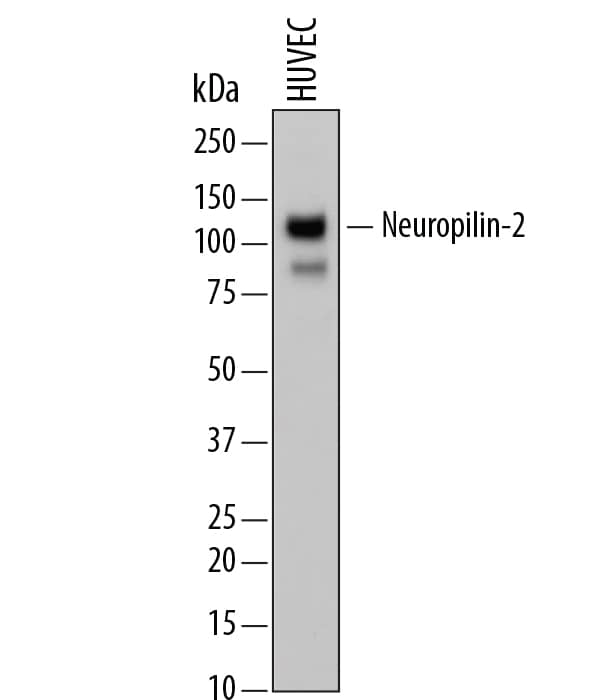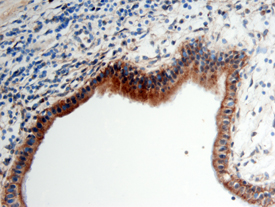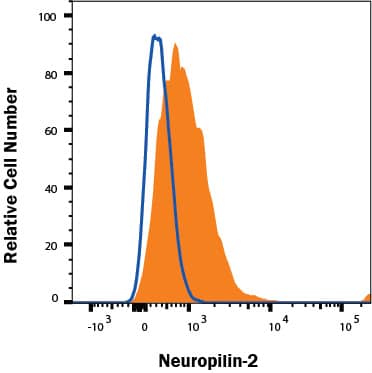Human/Mouse/Rat Neuropilin-2 Antibody
R&D Systems, part of Bio-Techne | Catalog # AF2215


Key Product Details
Species Reactivity
Validated:
Cited:
Applications
Validated:
Cited:
Label
Antibody Source
Product Specifications
Immunogen
Gln23-Tyr855
Accession # Q7LBX6
Specificity
Clonality
Host
Isotype
Endotoxin Level
Scientific Data Images for Human/Mouse/Rat Neuropilin-2 Antibody
Detection of Human Neuropilin‑2 by Western Blot.
Western blot shows lysates of HUVEC human umbilical vein endothelial cells. PVDF membrane was probed with 0.5 µg/mL of Goat Anti-Human/Mouse/Rat Neuropilin-2 Antigen Affinity-purified Polyclonal Antibody (Catalog # AF2215) followed by HRP-conjugated Anti-Goat IgG Secondary Antibody HAF109). A specific band was detected for Neuropilin-2 at approximately 120 kDa (as indicated). This experiment was conducted under reducing conditions and using Immunoblot Buffer Group 1.Neuropilin‑2 in Human Pancreatic Cancer Tissue.
Neuropilin-2 was detected in immersion fixed paraffin-embedded sections of human pancreatic cancer tissue using Goat Anti-Human/Mouse/Rat Neuropilin-2 Antigen Affinity-purified Poly-clonal Antibody (Catalog # AF2215) at 5 µg/mL overnight at 4 °C. Before incubation with the primary antibody, tissue was subjected to heat-induced epitope retrieval using Antigen Retrieval Reagent-Basic (CTS013). Tissue was stained using the Anti-Goat HRP-DAB Cell & Tissue Staining Kit (brown; CTS008) and counterstained with hematoxylin (blue). View our protocol for Chromogenic IHC Staining of Paraffin-embedded Tissue Sections.Detection of Human, Mouse, and Rat Neuropilin‑2 by Simple WesternTM.
Simple Western lane view shows lysates of HUVEC human umbilical vein endothelial cells, C6 rat glioma cell line, LL/2 mouse Lewis lung carcinoma cell line, and bEnd.3 mouse endothelioma cell line, loaded at 0.2 mg/mL. A specific band was detected for Neuropilin-2 at approximately 140 kDa (as indicated) using 10 µg/mL of Goat Anti-Human/Mouse/Rat Neuropilin-2 Antigen Affinity-purified Polyclonal Antibody (Catalog # AF2215) followed by 1:50 dilution of HRP-conjugated Anti-Goat IgG Secondary Antibody HAF109). This experiment was conducted under reducing conditions and using the 12-230 kDa separation system.Applications for Human/Mouse/Rat Neuropilin-2 Antibody
Blockade of Receptor-ligand Interaction
CyTOF-ready
Flow Cytometry
Sample: HUVEC human umbilical vein endothelial cells
Immunohistochemistry
Sample: Immersion fixed paraffin-embedded sections of human pancreatic cancer tissue subjected to Antigen Retrieval Reagent-Basic (Catalog # CTS013)
Simple Western
Sample: HUVEC human umbilical vein endothelial cells, C6 rat glioma cell line, LL/2 mouse Lewis lung carcinoma cell line, and bEnd.3 mouse endothelioma cell line
Western Blot
Sample: HUVEC human umbilical vein endothelial cells
Reviewed Applications
Read 2 reviews rated 3 using AF2215 in the following applications:
Formulation, Preparation, and Storage
Purification
Reconstitution
Formulation
Shipping
Stability & Storage
- 12 months from date of receipt, -20 to -70 °C as supplied.
- 1 month, 2 to 8 °C under sterile conditions after reconstitution.
- 6 months, -20 to -70 °C under sterile conditions after reconstitution.
Background: Neuropilin-2
Neuropilin-2 (Npn-2) is a 120 kDa, type I transmembrane (TM) glycoprotein that is related to the semaphorin receptor now known as Neuropilin-1 (1). Npn-2 is a complex molecule with multiple splice forms. Five transmembrane forms are known, and one 62 kDa soluble form has been identified (2). Based on the originally reported precursor size of 909 amino acids (aa), the “standard” precursor in human will have a 20 aa signal sequence, an 842 aa extracellular region, a 25 aa TM segment, and a 42 aa cytoplasmic tail (1). The extracellular region contains two N-terminal CUB (C1r/Ugef/BMP-1) domains, two jellyroll-shaped coagulation factor V type C domains, and a juxtamembrane MAM (meprin/A-5 protein/tyrosine phosphatase μ) domain (1, 3). The CUB and factor V domain are involved in VEGF and semaphorin binding. The MAM domain appears necessary for signaling through plexin-1 (4). The five transmembrane isoforms all share the same CUB, factor V and MAM domains. Splicing begins at aa 809, seven amino acids after the end of the MAM domain, and it involves the end of the extracellular region, the TM segment, and the cytoplasmic domain (a total of 101 aa). Two of the four variants show a complete replacement of these 101 aa with a totally unrelated stretch of approximately 90 aa. This creates a new TM and cytoplasmic tail. These forms are called “Npn-2b” forms. Two other isoforms (plus the standard 909 aa form) retain the 101 aa stretch, and add either 17 or 22 aa to the end of the extracellular region. These forms are called “Npn-2a” forms. The isoform offered by R&D Systems is the “a” form with the 17 aa addition. This isoform shows 94% aa identity to the equivalent regions in mouse and rat Npn-2. The soluble form of Npn-2 is 555 aa in precursor length, and contains the two CUB domains plus the first 1½ factor V type C domains (1). Npn-2 binds Sema3B through F, and VEGF isoforms 165, 145, PlGF-2, and VEGF-C (5). It is known to form homodimers and heterodimers with Npn-1, and it forms receptor complexes with plexin-1 and VEGF R1 (4, 5). Npn-2 is found on a variety of cell types including neurons (motor, autonomic, sensory), vascular endothelial cells, Schwann cells and pancreatic acinar cells.
References
- Chen, H. et al. (1997) Neuron 19:547.
- Rossignol, M. et al. (2000) Genomics 70:211.
- He, Z. and M. Tessier-lavigne (1997) Cell 90:739.
- Nakamura, F. and Y. Goshima (2002) Adv. Exp. Med. Biol. 515:55.
- Neufeld, G. et al. (2002) Adv. Exp. Med. Biol. 515:81.
Alternate Names
Gene Symbol
UniProt
Additional Neuropilin-2 Products
Product Documents for Human/Mouse/Rat Neuropilin-2 Antibody
Product Specific Notices for Human/Mouse/Rat Neuropilin-2 Antibody
This product or the use of this product is covered by U.S. Patents owned by The Regents of the University of California. This product is for research use only and is not to be used for commercial purposes. Use of this product to produce products for sale or for diagnostic, therapeutic or drug discovery purposes is prohibited. In order to obtain a license to use this product for such purposes, contact The Regents of the University of California.
U.S. Patent # 6,054,293, 6,623,738, and other U.S. and international patents pending.
For research use only


